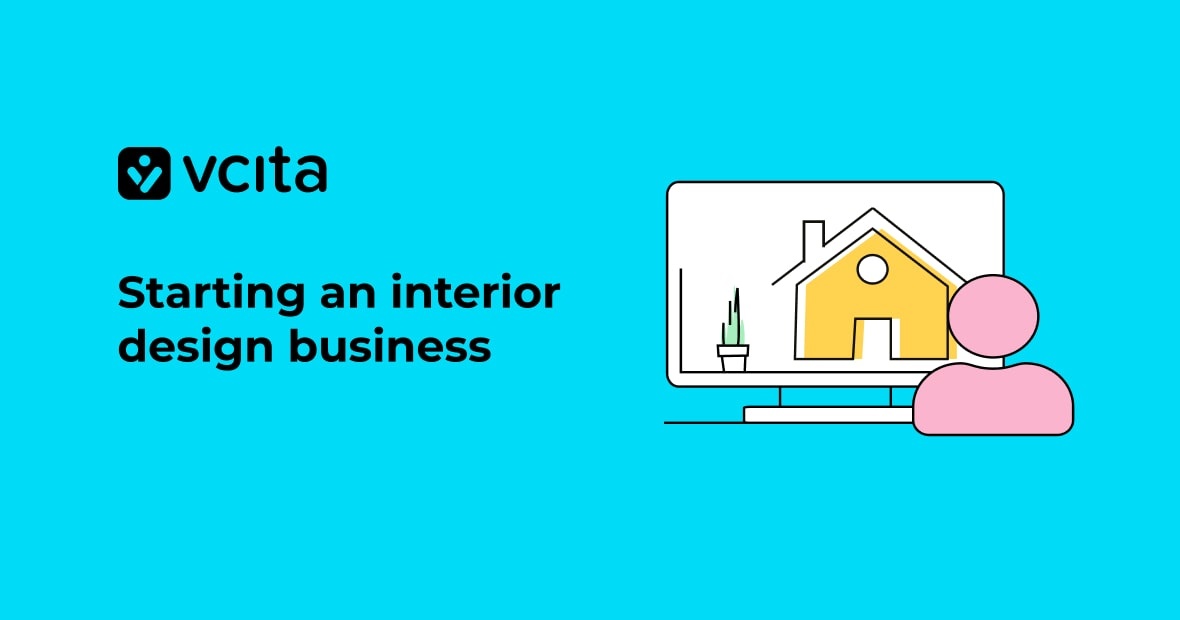Starting your own interior design business can seem overwhelming, but with the right tools and strategy you can make your dream a reality. In this guide, you’ll learn about everything from building a business plan and establishing your business to attracting your first clients and managing the design process.
Follow these tips to successfully start your own interior design business in the growing interior design industry.
Laying the groundwork to start your interior design business
To start your own interior design business, you need a solid plan in place. This will help you define your vision, target the right customers, and set yourself up for success. Here are the first steps you need to take towards your successful interior design company.
Develop a business plan
A solid business plan helps you outline your vision and the steps needed to achieve it. It will be crucial for obtaining funding and keeping you on track. Your business plan should include things like your business goals and objectives, your target market and marketing strategy, financial projections, and what design services you want to offer.
Decide on your business structure
Will you operate as a sole proprietor, a partnership, an LLC, or corporation? Each one has its pros and cons, so consult with a lawyer to understand all the details and choose a structure that meets your needs. Whatever structure you choose, you should open a separate business bank account and consider applying for a business credit card, to keep your business finances separate from your personal accounts.
Define your target market and services
Do you want to focus on residential or commercial design? Maybe a niche like eco-friendly spaces or home staging? Determine what specific design services you want to offer, like space planning, lighting design or kitchen and bath design, and identify the types of people who need your services. This will help you effectively market to your target clients.
Obtain business licenses and insurance
Every business needs the relevant licenses and permits to operate legally. These vary depending on your city and state, so check the requirements at your local Chamber of Commerce. You’ll also need commercial liability insurance to protect yourself and your business.
Determine your services and fees
Look at the prices that other local interior designers are charging, to get an idea of what clients will expect to pay. When you calculate your rates, remember that the typical interior design services include initial consultations, space planning, furnishing and decorating, project management, and more. Offer package deals and discounts when possible to attract new clients.
Establishing your interior design brand and reaching potential clients
Branding is crucial for a successful interior design business. It’s the way that potential clients remember your business and can convince them to work with you instead of your competition. Take time to think about your logo and theme colors, and plan an effective marketing strategy to attract and retain customers.
Create a marketing strategy
Think about how you’ll attract and convert new customers. You’ll need a professional website that includes details about your services and prices, and showcases your previous work. You should also build a social media presence to increase visibility and build relationships, and set up email marketing systems to keep in touch with new leads and existing customers.
Nurture your online presence
Post updates, share photos of your latest design projects, and engage with followers on your social media channels. You can also start a blog on your website, to establish yourself as an interior design professional. Write about the latest trends in color palettes, space-saving furniture ideas, or how to stay on budget. Share the posts on your social media to drive traffic to your site.
Promote your business through your networks
Start networking by joining local interior design organizations and your chamber of commerce. Send press releases to local media outlets announcing your new business. Word-of-mouth and referrals from happy clients will become an important part of your marketing strategy over time.
Run promotions and special offers
It’s a good idea to offer promotions and discounts to attract new clients, and invite new clients to a free consultation. This allows potential clients to get to know you and understand the design process. Focus your marketing efforts on your target market, whether residential or commercial. Build relationships with real estate agents, home stagers, architects, and contractors who can refer clients to you.
Invest in the necessary tools
You’ll need designer software like AutoCAD,Floorplanner, or SmartDraw to create customized mood boards, floor plans, and 3D renderings. You’ll also want samples of fabrics, finishes, and a color palette to help clients visualize concepts. Don’t forget basic supplies like a notebook, tape measure, and camera.
Build your portfolio
As an interior designer, your work and style are your credentials. Start designing spaces for friends and family or offer discounted services to build your portfolio. Compile photos of your best design work, mood boards, and sketches to show potential clients your skills. Share photos of your designs on your website and social media platforms like Instagram to help attract new clients.
Mastering the interior design process from mood boards to color palettes
To launch an interior design business, you first need to master the design process. The key steps are: creating a mood board, determining a color palette, and selecting designer software.
Create a mood board
A mood board helps convey your design style to clients and gets them excited about your vision. Gather images of furniture, accessories, color swatches, and anything else that inspires your design aesthetic. Use a social media platform like Pinterest to create digital mood boards you can share with clients.
Determine a color palette
Choose a versatile color palette that represents your signature style. Aim for a palette of 3 to 5 colors that work well together in different combinations. Use color theory to create palettes that evoke specific moods, e.g. warm and cozy or fresh and bright. To refine your selection, try experimenting with a color picker to explore different shades and harmonies. Clients will come to associate these colors with your brand.
Select designer software
Interior design software like SmartDraw and Floorplanner make it easy to create 2D and 3D renderings of spaces so clients can visualize your designs. Many programs offer free trials so you can find one suited to your needs and budget. Look for software that is user-friendly but robust enough to handle complex commercial and residential design projects.
Stay on top of trends in the interior design industry
Last but not least, continuously educate yourself on the latest color palettes, design styles, and industry innovations. Follow trendsetters, read interior design blogs and publications, take additional courses, and stay up-to-date with tools and resources for interior designers. Meeting with other interior design professionals is also helpful for exchanging ideas and collaborating.
Managing the day-to-day operations of your new interior design business
While the creative work is rewarding, you’ll also need to manage the business aspects of your interior design company. This begins with obtaining the proper business licenses and insurance, and includes setting up business accounting to bill clients and pay vendors.
You’ll need to keep on top of daily admin tasks like marketing your services, answering emails, returning phone calls, and scheduling consultations. Consider using small business software like vcita to streamline booking, billing, and other operations.
Make your new interior design business a reality
Starting an interior design business requires dedication and hard work. But with the right tools, business licenses, and marketing strategy, you’ll be well on your way to launching your successful small business. With hard work and persistence, you’ll be well on your way to transforming spaces and bringing your clients’ visions to life.




























